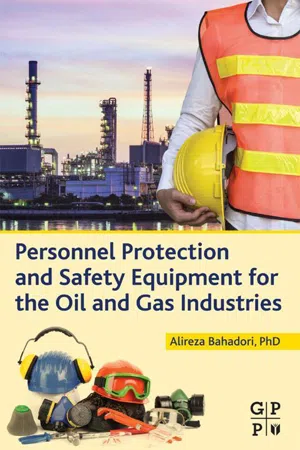
Personnel Protection and Safety Equipment for the Oil and Gas Industries
- 598 pages
- English
- ePUB (mobile friendly)
- Available on iOS & Android
Personnel Protection and Safety Equipment for the Oil and Gas Industries
About this book
Oil and gas companies are repeatedly cited by regulatory organizations for poor training and maintenance on providing personal protective equipment to their refinery workers. Managers of refinery and petrochemical plants are responsible for instructing their workers with the types of equipment available, how to properly wear the equipment, how to properly care and maintain the equipment, and, most importantly, it's their responsibility to enforce these regulations and safety requirements. While there are many reference materials on the subject, most are too broad to apply directly to the unique and highly volatile atmosphere of an oil and gas operation. Personnel Protection and Safety Equipment for the Oil and Gas Industries answers the call for safety managers onsite as well as workers to understand all the safety equipment available specifically for the energy sector. Condensed into one convenient reference location, this training guide is designed to inform on several types of personnel protective clothing, firefighting protective clothing, respiratory protective devises available as well as many other types of protective equipment, including fall protection and vehicle safety belts and harnesses. Industry-specific examples, multiple illustrations, and a glossary of terms make Personnel Protection and Safety Equipment for the Oil and Gas Industries a must-have on every oil and gas operation.- Know recommended US and international protective safety equipment regulations- Learn the types, classes, and materials of safety and protective equipment specific to the oil and gas industry- Gain knowledge on how to select, test, maintain, and store protective equipment properly
Frequently asked questions
- Essential is ideal for learners and professionals who enjoy exploring a wide range of subjects. Access the Essential Library with 800,000+ trusted titles and best-sellers across business, personal growth, and the humanities. Includes unlimited reading time and Standard Read Aloud voice.
- Complete: Perfect for advanced learners and researchers needing full, unrestricted access. Unlock 1.4M+ books across hundreds of subjects, including academic and specialized titles. The Complete Plan also includes advanced features like Premium Read Aloud and Research Assistant.
Please note we cannot support devices running on iOS 13 and Android 7 or earlier. Learn more about using the app.
Information
Breathing apparatus for personnel safety and protection
Keywords
1.1 Introduction
1.1.1 Minimal acceptable program
1.1.2 Medical limitations
Table of contents
- Cover image
- Title page
- Table of Contents
- Copyright
- Dedication
- Biography
- Preface
- Acknowledgments
- 1. Breathing apparatus for personnel safety and protection
- 2. Masks and respiratory equipment materials
- 3. Selection, inspection, and maintenance of respiratory protective equipment
- 4. Personnel safety and protective equipment
- 5. Personnel protection against radioactive
- 6. First aid and sanitation
- 7. Safety belts
- 8. Safety portable ladders
- 9. Safety and firefighting equipment, part 1
- 10. Safety and firefighting equipment, part 2
- Glossary of terms
- Additional list of reading on retrofitting
- References
- Index